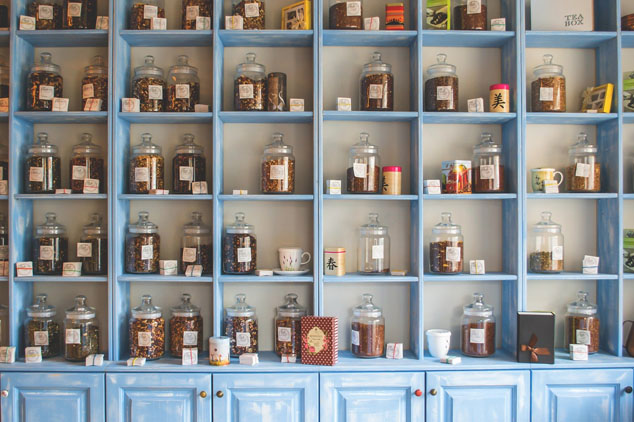 No! Natural alternatives, yes. Natural HCQ itself, definitely not. Saying otherwise is a bunch of poppycock! Here’s the truth you should know.
No! Natural alternatives, yes. Natural HCQ itself, definitely not. Saying otherwise is a bunch of poppycock! Here’s the truth you should know.
The sea of (mis)information about HCQ includes recipes for ‘making’ it from natural sources. Grapefruit leads the pack.
However, plants don’t make it. Neither does any other kinds of organism.
However, accurate information is available on what HCQ really is, where it comes from, what it’s supposed to do, how it applies to treating COVID-19, and how natural alternatives might simulate it.
The ‘Original’ HCQ
HCQ was originally created as a replacement for quinine in treating malaria. Quinine is a plant natural product from a group of shrubs and small trees known as Cinchona. It’s also very bitter (more or less like grapefruit).
Looking for a replacement for quinine was supposedly spurred on by the need for a less toxic malaria treatment.
Oh, yeah, and probably for the ‘need’ for a patentable drug with a higher profit margin. Thus, early research around 1950 led to the development of hydroxychloroquine (HCQ) as an alternative to quinine for treating malaria. Its synthesis was patented in 1951 (U.S. Patent No. 2,546,658).
Quinine and HCQ have been confused with one another for decades. It’s common to see HCQ referred to as a synthetic version of quinine. That’s a widespread myth that we can dispel by simply looking at their chemical structures to see they aren’t the same, as follows:
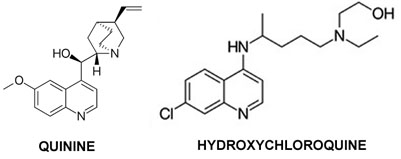
They also differ by their sources. Quinine is still freely available in tonic water, which is sold in supermarkets everywhere. It’s also sold as a nutraceutical supplement. HCQ, on the other hand, is a synthetic drug requiring a prescription for its use.
Okay, that was the easy part. Now what about how they work?
In other words, since there’s no natural HCQ, how does this synthetic drug compare with quinine?
Comparing HCQ and Quinine
This is where it gets pretty interesting. To keep things as simple as possible, start by comparing just this one aspect of their mechanisms of action according to that fount of all knowledge, Wikipedia:
1) Quinine is used for its toxicity to the malarial pathogen, Plasmodium falciparum, by interfering with the parasite’s ability to dissolve and metabolize hemoglobin.
2) The most accepted model is based on hydrochloroquinine [HCQ] and involves the inhibition of hemozoin biocrystallization, which facilitates the aggregation of cytotoxic heme.
TRANSLATION: They both provide protection for heme (as in hemoglobin), which is destroyed by malaria.
Among all the possible ways that HCQ and quinine might work, this may be the key to treating the cascade of destruction that begins with the infection. Indeed, it partially explains why one of the symptoms of malaria is hemolytic anemia – i.e., the abnormal breakdown of red blood cells.
All this information about malaria may seem academic, since it’s a nonexistent problem in the U.S. However, we can use it as a springboard for understanding COVID-19, based on certain similarities between the two infections.
The COVID-19 Connection
One of the early symptoms of COVID-19 is extreme fatigue, associated with drastic drops in blood oxygen levels. Both indicate severe oxygen deprivation (hypoxia).
An ‘idea’ paper, published online in mid-2020, provided an explanation for these symptoms as being due to the destruction of hemoglobin. A full copy of the article is available online free of charge. See below.
Liu W and Li H. 2020. COVID-19: Attacks the 1-Beta Chain of Hemoglobin and Captures the Porphyrin to Inhibit Human Heme Metabolism. ChemRxiv. Preprint. https://doi.org/10.26434/chemrxiv.11938173.v9.
This article has garnered some debate, so the basic hypothesis needs some experimental work for further support.
In spite of the need for further research, the article explains how and why COVID-19 reduces blood oxygen and causes the “crushed glass” imagery in lungs. It also accounts for certain other symptoms, such as increased levels of an iron-storage protein called ferritin. Its levels rise in response to excess iron being released by the destruction of hemoglobin.
Ferritin stores iron and releases it as needed. Ferritin levels rise as iron gets released by the destructive removal of heme from red blood cells.
Wait, there’s more!
Another critical heme protein also loses functionality. It’s a protein called cytochrome c oxidase. Its role is to provide the electronic energy needed for reducing mitochondrial oxygen for the formation of water.
How bad can that be? Consider this: that’s the same target for cyanide. Indeed, cyanide got its name from blue (cyanic) lips that people develop when their oxygen usage is cut off completely.
Okay, that’s a bit too much science-y gobbledygook for now. The point is that COVID-19 creates a double whammy by rendering cells unable to deliver or utilize oxygen.
as if a patient is being suffocated.
This is why certain treatments, such as HCQ, work in treating COVID-19.
It’s also why some of the first successful treatments arose in clinical settings where doctors used HCQ as one of the treatment modalities.
By the way, the development of hypoxia explains why symptomatic patients who can still breath do not get enough oxygen to their cells bodywide. The inflammation in the lungs results from the lungs not being able to perform oxygen/carbon dioxide exchange normally. This means COVID-19 is technically not a respiratory disease. Lung damage appears to be a secondary result of the hijacking of hemoglobin.
In other words, lung failure is due to the lack of oxygen in red blood cells and in mitochondria, not the cause of it. This also partially explains why cramming air into lungs by intubation is so dangerous and ineffective.
With that view, looking at COVID-19 through rose-colored (hemoglobin-colored?) glasses provides alternative treatment possibilities. This is where the search for natural HCQ alternatives shows promise.
Key Mineral for Protecting Hemoglobin
Start by taking a look at the interest in zinc as an adjunct for treating COVID-19. Some of the same clinics pioneering the use of HCQ against COVID-19 also discovered the value of this particular mineral.
Different studies of zinc’s role in treating COVID-19 contradict one another. For that reason I’ll just cite the best article I could find in support of its use in clinics, where the rubber really meets the road.
And – YAY! – it’s another article that’s free of charge online. See below.
Carlucci PM et al. 2020. Zinc sulfate in combination with a zinc ionophore may improve outcomes in hospitalized COVID-19 patients. J Med Microbiol. 69(10): 1228-1234.
Perhaps the key statement in the abstract of that article is:
…zinc sulphate increased the frequency of patients being discharged home, and decreased the need for ventilation, admission to the ICU and mortality or transfer to hospice for patients who were never admitted to the ICU.
THE ZINC LINK: HCQ is what is known as the zinc ionophore referred to in the title of the article cited above. This means HCQ works, at least in part, by transporting zinc ions into cells.
Ah, now we’re getting somewhere. It turns out that the first few steps of heme synthesis occur in mitochondria. Early on this process depends on a reaction catalyzed by an enzyme called aminolevulinic acid dehydratase, which is a zinc metalloenzyme.
In other words, making heme requires zinc.
Now we’ve arrived at the point where we can start looking for natural HCQ alternatives for their potential activities as zinc ionophores. These are the substances that simulate the zinc ionophore activity of HCQ, thereby providing some protection for heme against its destruction by the COVID-19 virus, SARS-CoV-2.
So far researchers have started evaluating four particular plant natural products for their ability to schlep zinc into cells. Note that the first two listed below are much easier to find from common sources than the other two.
All of these substances provide multiple health benefits. Links below are for their Wikipedia pages, which give you overwhelmingly okay information about their overall values as nutraceuticals [my opinion].
The four plant substances are:
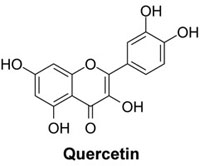
1) QUERCETIN. I’m starting with this substance because it’s a type of plant polyphenolic called a flavonoid. This class of plant natural products has been my specialty in plant biochemistry for about 50 years, so I’m biased in their favor. I love ’em and I think everybody should!
Quercetin occurs so commonly in many plants that it’s hard to escape it if you eat any kind of fruits and veggies. The average dietary intake is estimated to be less than 40 mg per day. Supplements of quercetin typically provide doses of 500 mg.
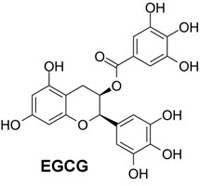
2) EGCG. Epigallocatechin gallate (EGCG) is another plant phenolic. It’s a flavonoid derivative among a class of substances called catechins. EGCG is the most abundant catechin in tea (Camellia sinensis).
Green tea has the highest amount, at about 74 mg per gram of dried leaves, followed by white tea (42 mg per gram) and black tea (just under 10 mg per gram). Supplements routinely provide around 200 mg of EGCG in a 400 mg dose of green tea extract.
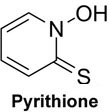
3) PYRITHIONE. The main food source for this organosulfur compound is Persian shallots (Alliium stipitata). This substance is only available as a zinc complex for topical uses.
Zinc pyrithione is considered to be toxic orally. The best strategy for consuming it is simply eating Persian shallots.
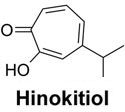
4) HINOKITIOL. There are no good dietary sources of hinokitiol, since it occurs only in the wood and bark of species in the cypress family (Cupressaceae).
Hinokitiol supplements are not routinely available from nutraceutical manufacturers. Its usual suppliers are chemical supply companies, where a typical cost is around $215 for a 250 mg bottle. That price alone will keep it off the shelves for average consumers.
Zinc Ionophore References
Hunting for natural zinc ionophores is a fairly new endeavor. Research is mostly very recent, especially when it’s directed toward viral disease such as COVID-19. That just means this topic is promising, although still fraught with many unanswered questions.
The following are ‘starter’ references for the really science-y geeks. They’ll point you in the right direction.
Krenn BM et al. 2009. Antiviral Activity of the Zinc Ionophores Pyrithione and Hinokitiol against Picornavirus Infections. J Virol. 83(1): 58-64.
Dabbagh-Bazarbachi H et al. 2014. Zinc Ionophore Activity of Quercetin and Epigallocatechin-gallate: From Hepa 1-6 Cells to a Liposome Model. J. Agric. Food Chem. 62(32): 8085–8093.
Hoang BX and Han B. 2020. A possible application of hinokitiol as a natural zinc ionophore and anti-infective agent for the prevention and treatment of COVID-19 and viral infections. Med Hypotheses. 145: 110333.
Getting Your Zinc AND Making It Work
The value of zinc vs. COVID-19 is becoming clearer with the latest research. What we know now is that zinc deficiency is a fairly common factor underlying the progression of a COVID-19 infection.
This article is one of the most recent articles expressing the importance of zinc supplementation in this regard.
Wessels I et al. 2020. The Potential Impact of Zinc Supplementation on COVID-19 Pathogenesis. Front. Immunol. 11: 1712.
The odd thing about the occurrence of zinc deficiency is that the RDA of zinc for adults is only 11 mg per day for men and 8 mg a day for women.
Even if you’re not sure about your own zinc levels, simply consuming high-zinc foods will give you plenty. The best food sources are:
- oysters, 3 ounces (oz): 74 mg
- beef patty, 3 oz: 5.3 mg
- Alaska king crab, 3 oz: 6.5 mg
- cooked lobster, 3 oz: 3.4 mg
- cooked pork chop loin, 3 oz: 2.9 mg<.li>
- baked beans, 1/2 cup serving: 2.9 mg
- dark meat chicken, 3 oz: 2.4 mg.
Supplementing with zinc is, of course, one option. However, zinc requires co-conspirators to work right. The main ones are selenium and vitamin D.
The best dietary sources for selenium include, in order: Brazil nuts, tuna, oysters, pork, beef, chicken, tofu, whole wheat pasta, shrimp, and mushrooms.
The BEST package for both zinc and selenium is obviously oysters.
Regarding vitamin D, dietary and supplement sources are inferior in many ways to what you can make in your skin when it’s exposed to UVB light from sunshine. If you’re still afraid of sunshine, based on dogmatic fear-mongering by the medical community, then take a look at what you’re missing, starting here: Heliophobia Makes Modern Disease for One and All.
The bottom line here is that eating oysters and getting out in the sunshine are phenomenally better natural defenses against COVID-19 than anything human-made.
Treating advanced cases of COVID-19 with zinc and ultra-high levels of vitamin D3 (2,000 IU per kg body weight daily!) has shown some success. Doesn’t it make more sense to simply consume zinc in foods and get outside in the sun to help slow down or prevent such drastic developments? In the immortal words of Gary Cooper, “Yup.”
General Suggestions
Think about this for a moment: Getting the RDA of any nutraceutical does not mean it fits your health context. You can consume zinc until the cows come home and not get anything out of it unless it gets to the right places in your cells and does what it’s supposed to do when it gets there.
This is why consuming natural zinc ionophores can play an important role. It’s also why naturally synthesized vitamin D3 works better than anything from supplements or foods.
After all that geeky explanation above about what COVID-19 really does and what to do about it, it just boils down to some advice you probably heard from your mother: eat your veggies and go outside and play.
One More Thing: The Big HCQ Caveat
Even though HCQ is a much stronger zinc ionophore than any natural alternatives to it, it’s still basically a toxic drug with severe side effects. Is has its place, in spite of the FDA’s decision to remove it from the emergency-use status for treating COVID-19. (Gee, do ya think this had something to do with coming up with the more favored drug, remdisivir? [Hint: remdisivir is a relatively newly patented drug. Hmm.])
Tip of the Iceberg
If an infection of any kind destroys or disrupts how you make and use heme for oxygen transport in red blood cells and for making water from oxygen in mitochondria, then the problem is hypoxia, not respiratory failure.
This means that this “tip of the iceberg” explanation is where scientific thinking should be directed. Protecting heme synthesis is just the beginning.
Fortunately, some early research is starting to point in this direction. Some of the better approaches for boosting oxygen levels now include hyperbaric oxygen therapy (HBOT), low-light (red) laser therapy (LLLT), and intravenous ozone therapy.
Since this post is already getting too long, these other topics will have to await my analyses in upcoming essays. Stay tuned!
Bottom Line About Natural HCQ
For now I just wanted to be sure you don’t get duped by misinformation about a so-called natural HCQ – which doesn’t exist.
All the best in natural health,
![]()
Statements on this page have not been evaluated by the Food and Drug Administration. This product is not intended to diagnose, treat, cure, or prevent any disease.
Dr d I always enjoy your blogs. Is there any evidence of an ionosphere effect of dulcimer and humid acids or of tetrathiomolybdate?
Hi Dr. David…Great questions – I had to dig around a little for answers. First, regarding ‘dulcimer’ – I don’t know what you really mean, since that term refers to a type of musical instrument. As for humic acids, they do influence absorption of copper and zinc, which go hand in hand (see: https://pubmed.ncbi.nlm.nih.gov/29580088/). Tetrathiomolybdate is a copper chelator with limited medical application (see: https://pubmed.ncbi.nlm.nih.gov/18683094/). I hope that helps.
Cheers,
Dr. D
There’s a very popular DIY HCQ recipe circulating that includes boiling grapefruit and lemon rinds. Although the flavonoids from the citrus rinds cannot be such a bad thing, is there any truth to this being a natural, albeit diluted, form of HCQ?
Hi, Kathie: No, there is absolutely no chance that HCQ can be produced by citrus. I saw that recipe and just about fell out of my chair with a combination of laughter and disgust. Laughter because it is so ludicrous. And disgust because it’s dangerous misinformation. The bitterness in citrus rinds, especially grapefruit, simulates the bitterness of quinine. However, the grapefruit’s bitter flavor is from a flavonoid and a terpenoid. You’re right that they’re not a bad thing. They’re just not HCQ.
Thanks for asking! Please spread this CORRECT information around, will you?
Cheers,
Dennis
Thanks for the insightful information. It seems there is a lot of misinformation going around with treatments. I can tell you know your stuff! I found this post after I just bought a Quinine supplement: https://www.amazon.com/gp/product/B087HK97L5/ref=ppx_yo_dt_b_asin_title_o00_s00?ie=UTF8&psc=1 There seem to be a lot of people saying to take it with ionic zinc and it helps… curious to hear your thoughts? Thanks!
Absolutely, Meredith. The early successes against COVID-19 in small clinics included zinc as an ingredient for successful treatment protocols. After all, quinine (and HCQ) is a zinc ionophore, so it’s effects depend on getting enough zinc.
Cheers,
Dennis
Hi Dr. Clark. I’ve been taking 500 mg of quercetin, but d 3 ,zinc and vitamin c but the Quercetin is really upsetting my stomach and affecting my Gerd. Could I substitute the Quercetin for something else? Thankyou.
Hi, Alison: Great question. Sometimes these unexpected side effects happen. Some of my supplements do that to me, too. As for quercetin, let me point out a product that might provide relief PLUS better absorbability. It’s called a quercetin phytosome. One of the companies that offers it is Life Extension, here: https://www.lifeextension.com/vitamins-supplements/item02302/bio-quercetin. It’s not too expensive. See how it works for you. Good luck!
Cheers,
Dennis
So if I understand correctly a small amount of Zinc…any kind?…is adequate?
We had covid and increased our zinc while recovering.
This was a very helpful write up and I thank you for that. I was about to make the grapefruit and lemon thing and now I will just eat those instead.
Good points, Robyn. As for zinc, just about any easily ionizable form (i.e., outside of metallic zinc) will do. I take zinc picolinate, 50 mg – making sure to take it with 200 mcg of selenium. I also eat lots of high-zinc foods, starting with oysters.
Glad you can enjoy the citrus as intended … i.e., as food. Enjoy!
Cheers,
Dennis
Hello, I just came across this post and I’m so glad you wrote this! Was almost suckered into the grapefruit & lemon water also. My question is though, since quinine is found in tonic water, would pairing tonic water with zinc give you the same pre-hcq treatment they used for malaria in the early days? Aside from that, would it provide similar affects as hcq treatment for COVID 19?
Thanks for this article! Very very helpful!
Hi, Rachel:
I’m happy to hear you avoided the grapefruit scam. As for your questions, I’m not sure how to make comparisons between tonic water and HCQ. However, it does sound logical to me about pairing quinine and zinc, since that’s nearly the same as pairing HCQ and zinc. Both substances have the same mechanism of action.
Cheers,
Dennis